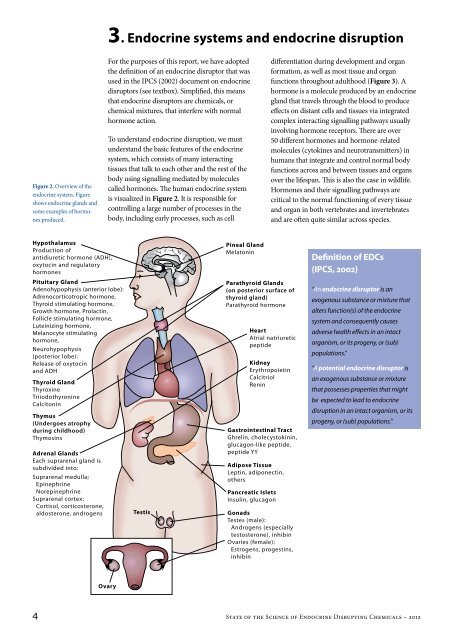Endocrine Disrupting Chemicals 2012 - World Health Organization
Endocrine Disrupting Chemicals 2012 - World Health Organization
Endocrine Disrupting Chemicals 2012 - World Health Organization
You also want an ePaper? Increase the reach of your titles
YUMPU automatically turns print PDFs into web optimized ePapers that Google loves.
3. <strong>Endocrine</strong> systems and endocrine disruption<br />
Figure 2. Overview of the<br />
endocrine system. Figure<br />
shows endocrine glands and<br />
some examples of hormones<br />
produced.<br />
For the purposes of this report, we have adopted<br />
the definition of an endocrine disruptor that was<br />
used in the IPCS (2002) document on endocrine<br />
disruptors (see textbox). Simplified, this means<br />
that endocrine disruptors are chemicals, or<br />
chemical mixtures, that interfere with normal<br />
hormone action.<br />
To understand endocrine disruption, we must<br />
understand the basic features of the endocrine<br />
system, which consists of many interacting<br />
tissues that talk to each other and the rest of the<br />
body using signalling mediated by molecules<br />
called hormones. The human endocrine system<br />
is visualized in Figure 2. It is responsible for<br />
controlling a large number of processes in the<br />
body, including early processes, such as cell<br />
differentiation during development and organ<br />
formation, as well as most tissue and organ<br />
functions throughout adulthood (Figure 3). A<br />
hormone is a molecule produced by an endocrine<br />
gland that travels through the blood to produce<br />
effects on distant cells and tissues via integrated<br />
complex interacting signalling pathways usually<br />
involving hormone receptors. There are over<br />
50 different hormones and hormone-related<br />
molecules (cytokines and neurotransmitters) in<br />
humans that integrate and control normal body<br />
functions across and between tissues and organs<br />
over the lifespan. This is also the case in wildlife.<br />
Hormones and their signalling pathways are<br />
critical to the normal functioning of every tissue<br />
and organ in both vertebrates and invertebrates<br />
and are often quite similar across species.<br />
Hypothalamus<br />
Production of<br />
antidiuretic hormone (ADH),<br />
oxytocin and regulatory<br />
hormones<br />
Pituitary Gland<br />
Adenohypophysis (anterior lobe):<br />
Adrenocorticotropic hormone,<br />
Thyroid stimulating hormone,<br />
Growth hormone, Prolactin,<br />
Follicle stimulating hormone,<br />
Luteinizing hormone,<br />
Melanocyte stimulating<br />
hormone,<br />
Neurohypophysis<br />
(posterior lobe):<br />
Release of oxytocin<br />
and ADH<br />
Pineal Gland<br />
Melatonin<br />
Definition of EDCs<br />
(IPCS, 2002)<br />
Thyroid Gland<br />
Thyroxine<br />
Triiodothyronine<br />
Calcitonin<br />
Thymus<br />
(Undergoes atrophy<br />
during childhood)<br />
Thymosins<br />
Adrenal Glands<br />
Each suprarenal gland is<br />
subdivided into:<br />
Suprarenal medulla;<br />
Epinephrine<br />
Norepinephrine<br />
Suprarenal cortex:<br />
Cortisol, corticosterone,<br />
aldosterone, androgens<br />
Testis<br />
Parathyroid Glands<br />
(on posterior surface of<br />
thyroid gland)<br />
Parathyroid hormone<br />
Heart<br />
Atrial natriuretic<br />
peptide<br />
Kidney<br />
Erythropoietin<br />
Calcitriol<br />
Renin<br />
Gastrointestinal Tract<br />
Ghrelin, cholecystokinin,<br />
glucagon-like peptide,<br />
peptide YY<br />
Adipose Tissue<br />
Leptin, adiponectin,<br />
others<br />
Pancreatic Islets<br />
Insulin, glucagon<br />
Gonads<br />
Testes (male):<br />
Androgens (especially<br />
testosterone), inhibin<br />
Ovaries (female):<br />
Estrogens, progestins,<br />
inhibin<br />
“An endocrine disruptor is an<br />
exogenous substance or mixture that<br />
alters function(s) of the endocrine<br />
system and consequently causes<br />
adverse health effects in an intact<br />
organism, or its progeny, or (sub)<br />
populations.”<br />
“A potential endocrine disruptor is<br />
an exogenous substance or mixture<br />
that possesses properties that might<br />
be expected to lead to endocrine<br />
disruption in an intact organism, or its<br />
progeny, or (sub) populations.”<br />
Ovary<br />
4 State of the Science of <strong>Endocrine</strong> <strong>Disrupting</strong> <strong>Chemicals</strong> – <strong>2012</strong>
















